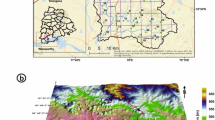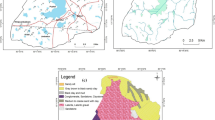Abstract
This study addresses a framework to evaluate and map environmental hazard with reference to spatial distribution of major and trace metal contamination and its relationship with lithology in Chandrapur district of Maharashtra, India using geospatial, statistical and GIS tools. In all, 208 ground water and 35 surface water samples were collected using global positioning system (GPS) synoptically with satellite imagery IRS P6 LISS III and were analyzed in ICP-AES. Analytical results reflect the presence of major and trace metals in ground water in terms of % as Fe (48%), Mn (12%), Zn (9%), Al (8%), Pb (7%), Cu (6%), Ni (4%), Cd (3%) and Cr (3%) of the total average concentration. The contamination is attributed to weathering of rocks and also to mining activities. Similarly, surface water contribution of major and trace metals was found as Al (47.8%), Fe (42.8%), Mn (5.5%), Zn (2.3%), Pb (0.56%), Ni (0.42%), Cu (0.16%), Cr (0.16%) and Cd (0.10%) of the total average concentration. Ordinary kriging interpolation method was adopted to assess the spatial distribution of different major and trace metals in groundwater samples with their best model fit variogram Classical statistical method like principal component analysis (PCA) was carried out in order to establish correlation between spatial pattern of metal contamination and geology of the area in GIS environment. Various surface and subsurface aspects like landuse/land cover, structural features, hydrogeology, topography etc were also considered to ascertain their impact to supplement the inference of the study.













Similar content being viewed by others
References
Alloway BJ (1990) Heavy metals in soils. Blackie, London
APHA (1992) American water works association and water pollution control federation. Standard methods for the examination of water and wastewater, 18th edn. American Public Health Association (APHA), New York
Atteia O, Dubois JP, Webster R (1994) Geostatistical analysis of soil contamination in the Swiss Jura. Environ Pollut 86:315–327
BAMAS (Litani Basin Management Advisory Services) (2005) Litani Water Quality Management Project. http://lebanon.usaid.gov/files/BAMAS%20Rapid%20Review%20Report.doc
Buys J, Botha JF, Messerschmidt HJ (1992) Triangular irregular meshes and their application in the graphical representation of geohydrological data. Report No 271/2/92 Water Research Commission
Campbell J (1998) Map use and analysis, chap 11. McGraw-Hill, New York, pp 170–189
Carlon C, Critto A, Marcomini A, Nathanail P (2001) Risk based characterisation of contaminated industrial site using multivariate and geostatistical tools. Environ Pollut 111:417–427
Cook JM, Edmunds WM, Robins NS (1991) Groundwater contribution to an acid upland lake (Loch Fleet, Scotland) and the possibilities for amelioration. J Hydrol 125:111–128
Department of Geology, University of Otago, New Zealand (2005) Metals in groundwater. http://www.otago.ac.nz/geology/features/metals/groundwater.html
Deutsch CV, Journel AG (1998) GSLIB: geostatistical software library and user’s guide, 2nd edn. Oxford University Press, New York
Einax JW, Zwanzinger HW, Geib S (1997) Chemometrics in environmental analysis. Wiley-VCH, Weinheim
ESRI (1995) Cell-based modelling with grid. On-line computer help system. Environmental Systems Research Incorporated, Redlands
ESRI (Environmental Systems Research Institute), USA (1998) Using the arcinfo kriging technique to interpolate groundwater quality in KwaZulu/Natal, South Africa. http://gis.esri.com/library/userconf/proc98/proceed/TO800/PAP781/P781.htm
Facchinelli A, Sacchi E, Mallen L (2001) Multivariate statistical and GIS-based approach to identify heavy metal sources in soils. Environ Pollut 114:245–276
Fang TH, Hong E (1999) Mechanisms influencing the spatial distribution of trace metals in surficial sediments off the southwestern Taiwan. Mar Pollut Bull 38(11):1026–1037
Filcheva E, Noustorova M (2000) Organic accumulation and microbial action in surface coal-mine spoils, Pernik, Bulgaria. Ecol Eng 15:1–15
Fleischer M (1969) U.S. Geological Survey standards-I. Additional data on rocks G-l and W-l, 1965–1967. Geochim Cosmochim Acta 32:65–79
Fleisher VD, Garlick WG, Haldane R (1976) Geology of the Zambian Copperbelt. In: Wolf KH (ed) Handbook of strata-bound and stratiform ore deposit, vol 6. Elsevier, Amsterdam
Frost RC (1979) Evaluation of the rate of decrease in the iron content of water pumped from a flooded shaft mines in County Durham, England. J Hydrol 40(1/2):101–111
Goodchild MF, Parks BO, Steyaret LT (1993) Environmental modelling with GIS. Oxford University Press, New York
Goovaerts P (1997) Geostatistics for natural resources evaluation. Oxford University Press, New York, 483 pp
Goovaerts P (1999) Geostatistics in soil science: state of the art and perspectives. Geoderma 89:1–45
Goovaerts P (2001) Geostatistical modelling of uncertainty in soil science. Geoderma 103:3–26
Haigh MJ (1993) Surface mining and the environment in Europe. Int J Surf Min Reclam 7:91–104
Haigh MJ (1995) Soil quality standards for reclaimed coalmine disturbed lands: a discussion paper. Int J Surf Min Reclam Environ 9:187–202
Hassett DJ (1994) Scientifically valid leaching of coal conversion solid residues to predict environmental impact. Fuel Process Technol (Spec Issue) 39:445–59
Helsel DR (1990) Less than obvious; statistical treatment of data below the detection limit. Environ Sci Technol 24(12):1766–1774
Helsel D, Cohn T (1988) Estimation of descriptive statistics for multiply censored water quality data. Water Resour Res 24:1997–2004
Helsel DR, Hirsch RM (1992) Statistical methods in water resources. Elsevier Science Publishers, B.V., New York, pp 357–408
Hem JD (1989) Study and Interpolation of the chemical characteristics of natural water. Water supply paper 2254, 3rd edn, US Geological Survey, Washington, D.C., 263 pp
Hwang CK, Cha JM, Kim KW, Lee HK (2001) Application of multivariate statistical analysis and geographical information system to trace element contamination in the Chungnam coal mine area, Korea. Appl Geochem 16:1455–1464
Isaaks EH, Srivastava RM (1989) Applied geostatistics. Oxford University Press, New York, 561 pp
Journel AG, Huijbregts CJ (1978) Mining geostatistics. Academic Press, New York, 600 pp
Kabata-Pendias A, Pendias H (1992) Trace elements in soils and plants, 2nd edn. CRC Press, Boca Raton
Kackstaetter UR, Heinrichs G (1997) Validity of low cost laboratory geochemistry for environmental applications. Water Air Soil Pollut 95:119–131
Karathanasis AD, Thompson YL, Evangelou VP (1990) Temporal solubility of aluminum and iron leached from coal spoil and contaminated soil materials. J Environ Qual 19:389–395
Keller EA (1995) Environmental Geology. Prentice Hall, New Jersey, 292 pp
Klavins M, Briede A, Rodinov V, Kokorite I, Parele E, Klavina I (2000) Heavy metals in Rivers of Latvia. Sci Total Environ 262:175–183
Krothe NC, Edkins JE, Schubert JP (1980) Leaching of metals and trace elements from sulfide-bearing coal waste in southwestern Illinois. In: Graves DH (eds) Proceedings of the symposium on surface hydrology, sedimentology and reclamation. University of Kentucky OES Publications, Lexington, pp 455–463
Lee CS, Li X, Shi W, Cheung CS (2006) Thornton I. Metal contamination in urban, suburban, and country park soils of Hong Kong: a study based on GIS and multivariate statistics. Sci Tot Environ 356:45–61
Li FC (1988) Environmental effect of coal mine spoil and general method for against pollution. Chongqing Environ Sci 10:17–21
Liaghati T, Preda M, Cox M (2003) Heavy metal distribution and controlling factors within coastal plain sediments, Bells Creek catchment, southeast Queensland, Australia. Environ Int 29:935–948
Lopez-Pamo E, Barettino UC, Anton-Pacheco G, Ortiz JC, Arranz JC, Gumiel B, Martınez-Pledel M Aparicio, Montouto O (1999) The extent of the Aznalcollar pyritic sludge spill and its effects on soils. Sci Tot Environ 242:57–88
Matheron G (1970) The theory of regionalized variables and its applications. Les Cahiers du Centre de Morphologie mathematique. Fascicule V. Ecole de Mine de Paris, 211 pp
Mathess G (1982) The properties of ground water. Wiley, New York, 406 pp
MPCB (Maharashtra Pollution Control Board) (2006) Environmental status and action plan for control of pollution at Chandrapur, 1–26 pp
Oguchia T, Jarvieb HP, Neal C (2000) River water quality in the Humber catchment: an introduction using GIS-based mapping and analysis. Sci Tot Environ 251/252:9–26
Olea R (ed) (2001) Geostatistical glossary and multilingual dictionary. Oxford University Press, New York
Parker RL (1967) Data of geochemistry: composition of the earth’s crust. U. S. Geological Survey Professional Paper 440-D
Poulin R, Hadjigeorgiou J, Lawrence RW (1996) Layered mine waste co-mingling for mitigation of acid rock drainage. Transit Inst Min Metal 105:A55–A62
Ramsey MH, Thompson M, Hale M (1992) Objective evaluation of precision requirements for geochemical analysis using robust analysis of variance. J Geochem Expl 44:23–36
Rivail Da Silva M, Lamotte M, Donard OFX, Soriano-Sierra EJ, Robert M (1996) Metal contamination in surface sediments of mangroves, lagoons and Southern Bay in Florianopolis Island. Environ Technol 17:1035–1046
Robins NS (2002) Groundwater quality in Scotland: major ion chemistry of the key groundwater bodies. Sci Tot Environ 294:41–56
Salomons W (1995) Environmental impact of metals derived from mining activities: processes, predictions, prevention. J Geochem Explor 52(1–2):5–23
Scaccia S, Passerini S (2001) Determination of LiCF3SO3 and _-LiAlO2 in composite PEO-based polymer electrolytes by flame atomic absorption spectrometry. Talanta 55:35–41
Schurch M, Edmunds WM, Buckley D (2004) Three-dimensional flow and trace metal mobility in shallow Chalk groundwater, Dorset, United Kingdom. J Hydrol 292(1–4):229–248
Scokart PO, Meeus-Verdinne K, DeBorger R (1983) Mobility of heavy metals in polluted soils near Zn smelters. Water Air Soil Pollut 20:451–463
Szucs A, Jordan Gy, Qvarfort U (2000) Integrated modelling of acid mine drainage impact on a wetland stream using landscape geochemistry, GIS technology and statistical methods. In: Fabbri A (eds) Deposit and geo-environmental models for resource exploitation and environmental security. NATO ASI series book. Kluwer Academic Publishers, Dordrecht
Tam NFY, Wong YS (2000) Spatial variation of heavy metals in surface sediments of Hong Kong Mangrove Swamps. Environ Pollut 110:195–205
Tao S (1995) Kriging and mapping of copper, lead and mercury contents in surface soil in Shenzhen area. Water Air Soil Pollut 83:161–172
Todd DK (1980) Groundwater hydrology, 2nd edn. Wiley, New York, 535 pp
Turekian KK, Wedepohl KH (1961) Distribution of the elements in some major units of the Earth’s crust. Geol Soc Am Bull 72:175–192
Vine JD, Tourtelot EB (1970) Geochemistry of black shale deposit—a summary report. Econ Geol 65:253–272
Waller LA, Gotway CA (2004) Applied spatial statistics for public health data. Wiley, New York
Way DS (1973) Terrain analysis, a guide to site selection using aerial photographic interpretation. Ross Inc, Stroudsburg
Webster R, Oliver MA (2001) Geostatistics for environmental scientists. Wiley, Chichester
Wedepohl KH (1970) Handbook of geochemistry II. Springer, Heidenberg
Xue Q, Liang B, Wang Hui-yun Liu L (2006) Numerical simulation of trace element transport on subsurface environment pollution in coal mine spoil. J Trace Elem Med Biol 20:97–104
Yan G, Bradshaw AD (1995) The containment of toxic wastes: II. Metal movement in leachate and drainage at Parc Lead-Zinc Mine, North Wales. Environ Pollut 90(3):379–382
Acknowledgments
I wish to thank Dr. Sukumar Devotta, Director, NEERI for his constant guidance and encouragement in thrust areas of work. I am indebted to my teacher for his constant encouragement and support that has been provided while carrying out the work. Results shown in this paper are derived from Ph.D. work performed at Visvesvaraya National Institute of Technology (VNIT), Nagpur.
Author information
Authors and Affiliations
Corresponding author
Rights and permissions
About this article
Cite this article
Satapathy, D.R., Salve, P.R. & Katpatal, Y.B. Spatial distribution of metals in ground/surface waters in the Chandrapur district (Central India) and their plausible sources. Environ Geol 56, 1323–1352 (2009). https://doi.org/10.1007/s00254-008-1230-3
Received:
Accepted:
Published:
Issue Date:
DOI: https://doi.org/10.1007/s00254-008-1230-3




